Instrumented range/altitude is not for the missile, it's for the radar. Meaning the radar will pick up and track objects up to an altitude of 14Km, and if the object comes to below 6Km, ie, threatens ground units, then the QRSAM will engage it. Above 6Km, the IAF will go check it out, 'cause that's their area of responsibility.
Instrumented range/altitude just depends on what they think is tactically sufficient. Basically, it just filters out tracks outside that range. For example, the Bars radar has an instrumented range of 400Km. So, even if it picks up targets beyond that range, the radar will simply not show the target to the pilot, 'cause it's unnecessary information and there's nothing he can do about it anyway. That's all there is to it.
Of course, it's also possible that QRSAM can achieve targets beyond 6Km, all the way to 14Km. Even that makes sense, actually makes more sense. But 6Km is the IA's area of responsibility, so that's the altitude that was published for it. Meaning, QRSAM can achieve an altitude of 14Km, but the IA will never fire at a target at that altitude due to jurisdiction. Or it's possible they will fire at targets above 6Km only if the IAF gives the firing unit permission. So I think this is the more likely reason than the instrumented altitude.
maybe gradual upgrade happening







 , as far as taking permission from IAF is the question.
, as far as taking permission from IAF is the question.
